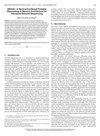Cost-Effective Extension of DRAM-PIM for Group-Wise LLM Quantization
IF 1.4
3区 计算机科学
Q4 COMPUTER SCIENCE, HARDWARE & ARCHITECTURE
引用次数: 0
Abstract
Processing-in-Memory (PIM) is emerging as a promising next-generation hardware to address memory bottlenecks in large language model (LLM) inference by leveraging internal memory bandwidth, enabling more energy-efficient on-device AI. However, LLMs’ large footprint poses significant challenges for accelerating them on PIM due to limited available space. Recent advances in weight-only quantization, especially group-wise weight quantization (GWQ), reduce LLM model sizes, enabling parameters to be stored at 4-bit precision or lower with minimal accuracy loss. Despite this, current PIM architectures experience performance degradation when handling the additional computations required for quantized weights. While incorporating extra logic could mitigate this degradation, it is often prohibitively expensive due to the constraints of memory technology, necessitating solutions with minimal area overhead. This work introduces two key innovations: 1) scale cascading, and 2) an INT2FP converter, to support GWQ-applied LLMs on PIM with minimal dequantization latency and area overhead compared to FP16 GEMV. Experimental results show that the proposed approach adds less than 0.6% area overhead to the existing PIM unit and achieves a 7% latency overhead for dequantization and GEMV in 4-bit GWQ with a group size of 128, compared to FP16 GEMV, while offering a 1.55× performance gain over baseline dequantization.成组LLM量化中DRAM-PIM的成本效益扩展
内存中处理(PIM)正在成为有前途的下一代硬件,通过利用内部内存带宽来解决大型语言模型(LLM)推理中的内存瓶颈,从而实现更节能的设备上人工智能。然而,由于可用空间有限,llm的大占用空间对在PIM上加速llm提出了重大挑战。仅权重量化的最新进展,特别是分组加权量化(GWQ),减小了LLM模型的尺寸,使参数能够以4位精度或更低的精度存储,同时精度损失最小。尽管如此,当前的PIM体系结构在处理量化权重所需的额外计算时仍会出现性能下降。虽然合并额外的逻辑可以缓解这种退化,但由于内存技术的限制,它通常非常昂贵,需要具有最小面积开销的解决方案。这项工作引入了两个关键的创新:1)规模级联,2)INT2FP转换器,与FP16 GEMV相比,以最小的去量化延迟和面积开销支持PIM上应用gwq的llm。实验结果表明,与FP16 GEMV相比,该方法在现有PIM单元的基础上增加了不到0.6%的面积开销,在分组大小为128的4位GWQ中实现了7%的去量化和GEMV延迟开销,同时提供了1.55倍的性能增益。
本文章由计算机程序翻译,如有差异,请以英文原文为准。
求助全文
约1分钟内获得全文
求助全文
来源期刊

IEEE Computer Architecture Letters
COMPUTER SCIENCE, HARDWARE & ARCHITECTURE-
CiteScore
4.60
自引率
4.30%
发文量
29
期刊介绍:
IEEE Computer Architecture Letters is a rigorously peer-reviewed forum for publishing early, high-impact results in the areas of uni- and multiprocessor computer systems, computer architecture, microarchitecture, workload characterization, performance evaluation and simulation techniques, and power-aware computing. Submissions are welcomed on any topic in computer architecture, especially but not limited to: microprocessor and multiprocessor systems, microarchitecture and ILP processors, workload characterization, performance evaluation and simulation techniques, compiler-hardware and operating system-hardware interactions, interconnect architectures, memory and cache systems, power and thermal issues at the architecture level, I/O architectures and techniques, independent validation of previously published results, analysis of unsuccessful techniques, domain-specific processor architectures (e.g., embedded, graphics, network, etc.), real-time and high-availability architectures, reconfigurable systems.
 求助内容:
求助内容: 应助结果提醒方式:
应助结果提醒方式:


